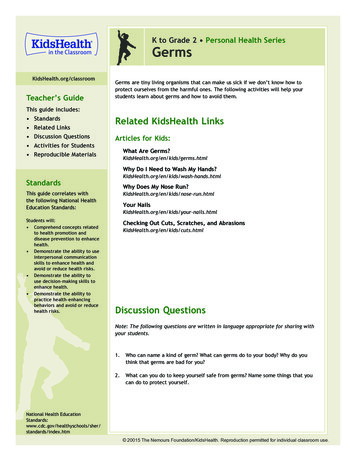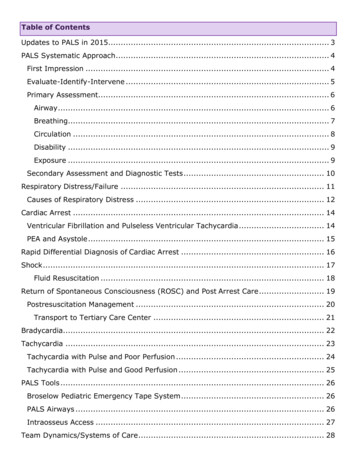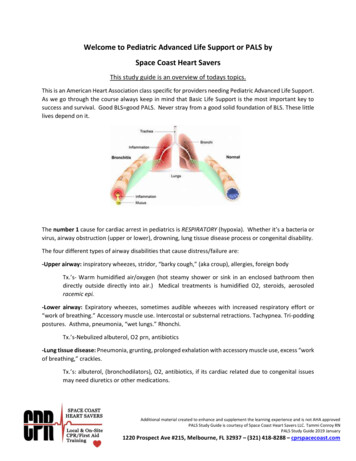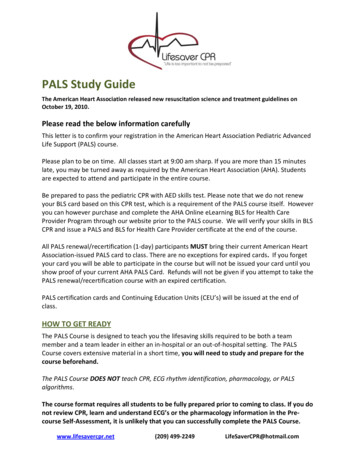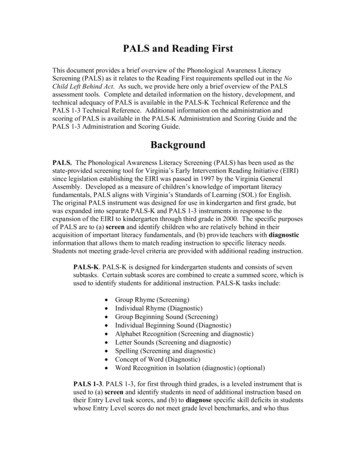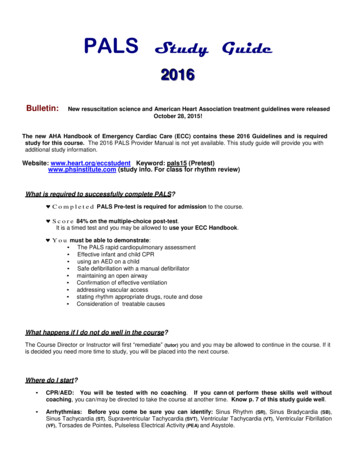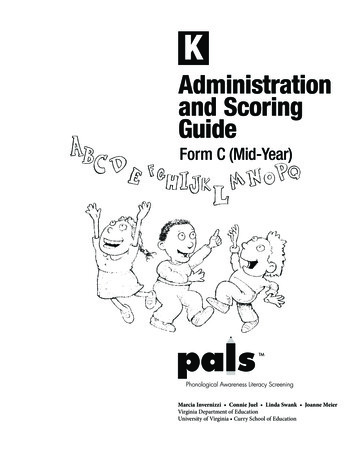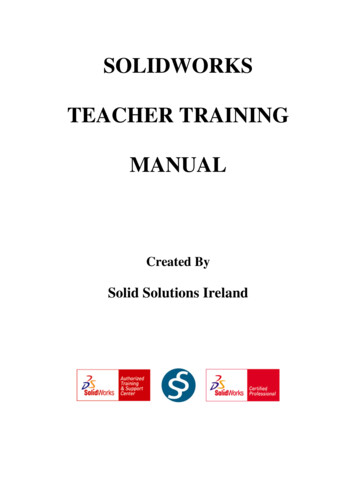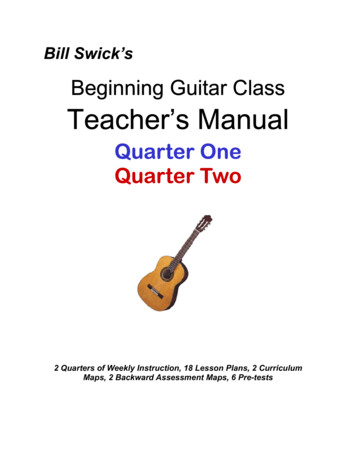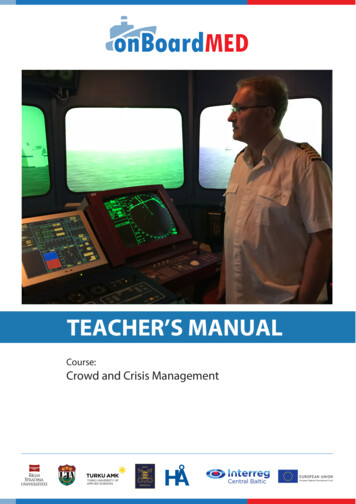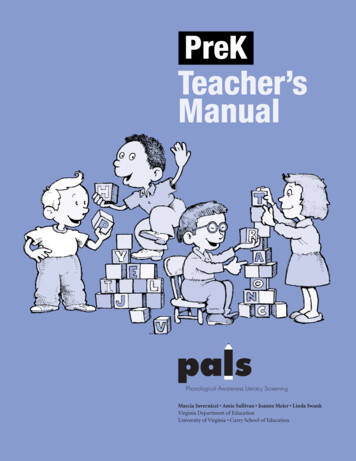
Transcription
PreKTeacher’sManualPhonological Awareness Literacy ScreeningMarcia Invernizzi Amie Sullivan Joanne Meier Linda SwankVirginia Department of EducationUniversity of Virginia Curry School of Education
All rights reserved. The Virginia Department of Education and Virginia schools participating in theVirginia Early Intervention Reading Initiative or the Virginia Preschool Initiative are licensed to duplicatethis assessment package for the contractual period, that is the 2004–2005 school year. No part of thesematerials protected by this copyright notice may be reproduced or utilized in any form or by any meansby persons or school divisions not participating in the Virginia Early Intervention Reading Initiative or theVirginia Preschool Initiative without prior written permission of the copyright owner. Reproductionand/or utilization includes electronic or mechanical, including photocopying, recording, or by anyinformation storage and retrieval system. 2004 University of Virginia. All Rights Reserved.For questions about PALS-PreK, please contact:Phonological Awareness Literacy Screening (PALS)1-888-UVA-PALS (1-888-882-7257) or (434) 982-2780Fax: (434) 982-2793e-mail address: pals@virginia.edu website: http://pals.virginia.eduFor information on obtaining large print editions, Braille editions, and closed-captioned video contact:Barbara Jones, Virginia Department of EducationOffice of Elementary Instructional Services20th Floor Monroe Building P. O. Box 2120Richmond, VA 23218-2120(804) 786-1997 Fax: (804) 786-1703e-mail: bjones@mail.vak12ed.eduLine Drawings: Casey RexrodeCover Illustration: Charles PealeGraphic Design: RoseberriesUniversity of Virginia Printing and Copying ServicesPrinted in the United States of America
47CHAPTER FIVEThe Development of PALS-PreKChildren’s literacy experiences before formal schooling can play an importantrole in their future success and achievement. Children who begin school withprior knowledge and skills in a variety of language and literacy areas are morelikely to become successful readers in the primary grades (Byrne, FieldingBarnesly, Ashley, & Larson, 1997; Raz & Bryant, 1990; Roskos et al., 2001;Scarborough, 1998; Snow et al., 1998; Storch et al., 2002). This underscores theneed for early childhood educators to (a) identify children’s literacy strengths,(b) recognize children who might experience future reading difficulties, and (c)promote classroom experiences that build early literacy skills. Using PALS-PreK,teachers can plan literacy experiences and instruction that best fit the needs ofeach individual child. The preschool setting is an optimal place for young children to build a strong foundation in all areas of development including languageand literacy.PALS-PreK assesses many of the emergent literacy factors shown by researchto predict later reading achievement. Most notable among these are phonologicalawareness and alphabet knowledge (Badian, 2000; Johnston, Anderson, &Holligan, 1996; Snow et al., 1998; Storch et al., 2002). The two best predictors ofearly reading achievement are the awareness of sound units within spoken words(Scarborough, 1998; Wagner et al., 1987; Watson, 2001), and accurate recognition of the letters of the alphabet (Adams, 1990; Badian, 2000; Byrne et al.,1989). PALS-PreK is a measure of young children’s knowledge of fundamentalaspects of phonological awareness and print knowledge, including: (a) namewriting, (b) alphabet recognition and letter sounds, (c) beginning sound awareness, (d) print and word awareness, (e) rhyme awareness, and (f) knowledge ofnursery rhymes.RationaleThe Phonological Awareness Literacy Screening for Preschool (PALS-PreK)was created due to the popularity of the original PALS assessment forkindergarten children and the need for early prevention of reading problems(Bowman et al., 2001; Burns, Griffin, & Snow, 1999; Foorman, Francis, Shaywitz,Shaywitz, & Fletcher, 1997). Virginia’s Preschool Initiative, which providesfunds for Virginia’s state-supported preschool programs serving at-risk childrenalso contributed to the development of PALS-PreK (for more information aboutthis initiative see the Virginia Department of Education’s Web site athttp://www.pen.k12.va.us/VDOE/Instruction/Elem M/early.html).The tasks presented in PALS-PreK are a representative sample of tasks foundin other measures of emergent literacy. Items were selected because of their previous history in emergent literacy research (Clay, 1985; Dickinson & McCabe, 2001;Dickinson & et al., 2001; Johnston et al., 1996; Liberman et al., 1985;Masonheimer, 1981). Administration procedures were developed based on psychoeducational research and research on developmentally appropriate practice forearly literacy assessment (Culbertson & Willis, 1993; NAEYC & IRA, 1998; Sattler,1988). Several well-documented assessments were reviewed and critiqued duringthe development of task presentation and format (i.e., Essential Skills Screener-Development
Preschool Version, 1995; Metropolitan Readiness Test, 6th Ed., 1995; Peabody PictureVocabulary Test-3rd Ed., 1997; PreLas 2000, 1998; Test of Reading Ability-3rd edition, 2001). Item selection and field-testing procedures for the tasks on PALSPreK are outlined in the sections that follow.48Item Developmentand Field TestingThe first step to providing teachers with a developmentally appropriate and robustinstrument was to select task items based upon scientific research in the area ofearly literacy. The next steps were to test the PALS-PreK items in a pilot study, collect suggestions for improvements, make necessary revisions, and re-pilot therevised tasks. Pilots were conducted in 14 different Virginia preschools during theSpring of 2000 and across the 2000–2001 academic year. Additionally, during the2002–2003 academic year, 287 preschool children from five different locations inVirginia participated in a field test of a revised beginning sound task. Finally, a newPALS-PreK assessment was piloted that included two revised tasks (BeginningSound and Rhyme Awareness) and two entirely new tasks (Nursery RhymeAwareness and Print and Word Awareness). Over the course of the 2003–2004 academic year, 138 preschool children from four different schools participated in thispilot, which included assessment on all PALS-PreK tasks. Reliabilities of the newtasks were examined and compared to reliability estimates for the previous versionof PALS-PreK. A description of the item-development process, pilots, and results isprovided in the following sections.It is important to note that while a summed score, consisting of the total ofscores from each PALS-PreK task, was included in the previous version of PALSPreK, a summed score is not calculated in the current version. This is dueprimarily to the limited usefulness of summing these scores. The nature andpurpose of PALS-PreK is to guide teachers’ efforts at planning literacy instruction. Therefore, comparing children’s scores to developmental ranges withinindividual tasks is believed to be much more useful to teachers. In the followingsections, any reference to a summed score refers to scores obtained using the previous version of PALS-PreK.Name WritingA child’s first attempt to convey meaning through written language often occurswhen that child learns to write the letters in his or her name (Bloodgood, 1999;Welsch, Sullivan, & Justice, 2003). In order to measure familiarity with writing, aname-writing task was included on PALS-PreK. Children’s writing behaviors canbe examined from a developmental perspective as they advance through variousstages, from a scribbled representation to a correct and recognizable signature(Ferrerio & Teberosky, 1982). The scoring of the name-writing task reflects thesevaried stages of development.Developing over time, name production represents a child’s cognitive processas s/he begins to understand the connection between written and spoken language (Liberman, 1985). A direct connection between literacy acquisition andname-writing ability has also been observed. In a study of preschool and kindergarten children, Bloodgood (1999) found that while all children made literacygains over the course of a school year, there was a clear relationship betweenname writing and other literacy tasks such as concept of word, beginning soundidentification, word recognition, and spelling. She also found significant correlations between children’s letter-naming and name writing ability, which increased
with age. Welsch et al. (2003) replicated these findings with a much larger sampleinvolving 3,546 four year olds. Thus, it appears that name writing is closely related to other literacy skills as each is derived from experiences with oral and written language.49Alphabet KnowledgeUpper-case alphabet recognition was chosen as a core component of PALS-PreKbased on early literacy research suggesting that the single best predictor of earlyreading achievement, on its own, is accurate, rapid naming of the letters of thealphabet (Adams, 1990; Badian, 2000; Snow et al., 1998). The results of the firstpilot study of PALS-PreK indicate that the participating preschool children consistently knew more upper than lower-case letters. In addition, data collectedfrom the original PALS assessment in 1997–1998 denoted a ceiling effect forkindergarten and first-grade children on the Upper-Case Alphabet Recognitiontask but not on the Lower-Case Alphabet Recognition task (Invernizzi, Robey, &Moon, 1999). Taken together, these data suggest that naming of upper-caseletters is the more developmentally appropriate task for preschool children(Masonheimer, 1981). Once a child demonstrates the ability to identify 16 ormore upper-case letters on PALS-PreK, then s/he moves to the Lower-CaseAlphabet Recognition task. Crosstab analyses revealed that children who are ableto name 9 or more lower-case letters were likely to also know some letter sounds,so PALS-PreK offers a Letter Sounds task for children who name 9 or morelower-case letters correctly.The 2000–2001 pilot study further demonstrates the predictive nature of theUpper-Case Alphabet Recognition task for reading success. Children’s Fall 2000scores on the Upper-Case Alphabet Recognition task were significantly correlatedwith their Spring 2001 PALS-PreK Summed Score (r .69, p .001) and accounted for 48% of the variance in spring scores.Beginning Sound Awareness and Rhyme AwarenessPhonological awareness refers to the ability to pay attention to, identify, andmanipulate sound units within spoken words. In particular, the researchliterature on phonological awareness identifies individual phoneme awareness assignificantly related to reading outcomes (Blachman, 2000; Morris et al., 2003;Swank & Catts, 1994). Research on emergent literacy continues to support theimportance of children’s skill with beginning phoneme identity, or beginningsound awareness, as they enter into the world of beginning reading (Byrne et al.,1997; Johnston et al., 1996).Items on the Beginning Sound Awareness task of PALS-PreK were selected tomeet three attributes of measurement. First, the items selected needed to be at anappropriate difficulty level for preschool children (i.e., neither too difficult nor tooeasy). Second, the selected items needed to have a strong predictive relationshipwith reading achievement. Measures of phoneme identity are well documented aspredictive of reading outcomes (Bradley & Bryant, 1985; Bryant et al., 1989;Bryant, MacLean, Bradley, & Crossland, 1990; Nicholson, 1997; Swank, 1997;Swank et al., 1994). Unlike the PALS-K (Invernizzi et al. 2003), which utilizes a pencil-and-paper, group format, the phonological awareness tasks on PALS-PreK assesschildren in an individual format using oral assessment procedures.Developmentally appropriate pictures with a prior history in phonologicalawareness research were selected for the Beginning Sound Awareness tasks onChildren’s Fall 2000scores on theUpper-Case AlphabetRecognition taskwere significantlycorrelated with theirSpring 2001 PALSPreK Summed Score(r .69, p .001) andaccounted for 48% ofthe variance in springscores.
50During the 2002–2003academic year, a totalof 289 preschoolchildren from12 preschools in fivedifferent geographicareas of theCommonwealth ofVirginia participatedin a pilot of therevised BeginningSound Awareness task.PALS-PreK. The items selected met the following two criteria: first, stimuli hadbeen used previously with preschool and primary age children to assess phonological awareness and predictive outcomes were established, and second, pictureswere easily recognizable and represented age-appropriate vocabulary. The firstcriterion was met by selecting stimuli from past prediction studies (Bradley etal., 1983, 1985; Bryant et al., 1990; Scarborough, 1998; Swank, 1997; Swank et al.,1994; Wagner et al., 1987). The second criterion was met by selecting picturetemplates and having an artist draw similar renderings of pictures used successfully with preschool children. The pictures represent one-syllable, high frequencywords that are appropriate for preschool children (Bear, et al. 2004). Only singlesyllable, concrete words that could be represented pictorially were selected.The 2002–2003 pilot study of PALS-PreK provided opportunities to (a) evaluate the other tasks on PALS-PreK, (b) determine the areas of the PALS-PreKthat require further pilot studies, and (c) establish a more comprehensive test ofbeginning sound knowledge. Revisions to the PALS-PreK Beginning SoundAwareness task for this study included (a) the addition of a third sound, (b)requiring children to produce the beginning sound rather than match a picture,(c) a change in the directions to suggest a teaching opportunity, and (d) revisedpictures. These changes were based upon feedback from teachers, commentsfrom the advisory review panel committee members, and literacy-expert advice.During the 2002–2003 academic year, a total of 289 preschool chi
of PALS-PreK. A description of the item-development process, pilots, and results is provided in the following sections. It is important to note that while a summed score, consisting of the total of scores from each PALS-PreK task, was included in the previous version of PALS-PreK, a summed score is not calculated in the current version. This is due
